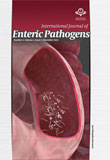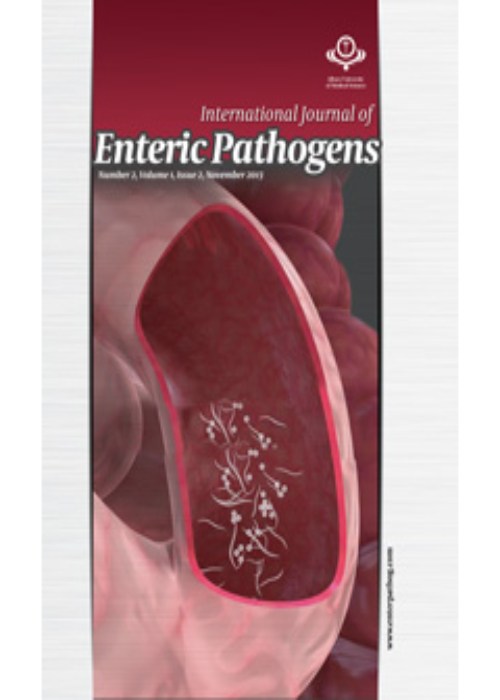فهرست مطالب

International Journal of Enteric Pathogens
Volume:5 Issue: 1, Feb 2017
- تاریخ انتشار: 1395/12/11
- تعداد عناوین: 8
-
-
Pages 1-4BackgroundIn cervical cancer, the carcinogenic mechanism of human papillomavirus (HPV) occurs through the integration of viral DNA into the host genome. This process initiates with a disruption in the E2 open reading frame (ORF) of the viral genome. Disruption of E2 ORF results in an increased expression of the viral oncoproteins, E6 and E7, by removal of E2 suppression effect on their promoters. E6 and E7 interfere with the normal cell cycle by degrading the p53 and pRb tumor suppressor proteins, respectively.ObjectivesThe objective of this study was to determine the physical status (episomal/integral) of HPV genome in esophageal squamous cell carcinoma (ESCC).Materials And MethodsThe rate of copy numbers of E2 and E6 genes in HPV-18 and HPV-16 positive samples were analyzed by quantitative polymerase chain reaction (qPCR) in order to assess the physical status (episomal/integral) of HPV. DNA extracts from HeLa cell line were used as the positive control.ResultsThe E2 gene was detected in 1 sample, co-infected with HPV-16 and HPV-18. While, E6 gene was detected in all 11 HPV positive samples. The qPCR analysis showed the presence of integrated form of viral DNA in all HPV positive samples and only 1 mixed episomal-integrated form was detected.ConclusionThe presence of integrated forms of high risk HPV-16 and HPV-18 genomes might reflect a crucial process towards malignant transformation of ESCC.Keywords: episomal, integrated, Human papilloma virus (HPV), Esophageal Squamous Cell Carcinoma (ESCC)
-
Pages 5-8BackgroundThe basic approaches for the treatment of human hydatidosis are surgery and chemotherapy. The risk of spillage of protoscoleces cannot be underestimated during surgery.ObjectivesThis study aimed to evaluate the scolicidal activity of Ephedra major methanol extracts against protoscoleces of hydatid cysts.Materials And MethodsVarious concentrations of the methanolic extracts (0.01%-0.001%, mg/mL) of different parts of E. major were used for exposure times of 10, 20, 30, and 60 minutes.ResultsDifferent extracts of E. major were tested, 0.1% concentration had strong scolicidal activity in 60 minutes. The stem extracts of 0.1% had very strong scolicidal effects in 60 minutes of exposure time and the mortality rate decreased with the lower concentration.ConclusionFindings showed that scolicidal effects of E. major root extracts against cystic echinococcosis protoscoleces were less effective, while the stem and leaf extracts demonstrated more activities, respectively.Keywords: Hydatid cyst, Ephedra major, Protoscolicidal activity, Echinococcus granulosus
-
Pages 9-12BackgroundPlasmid and chromosomal extended-spectrum beta-lactamases (ESBLs) have been increasingly spread everywhere and blaCTX-M1 is one predominant beta-lactamase.ObjectivesThis study was fulfilled to determine the production of ESBL and prevalence of blaCTX-M1, blaSHV, and blaTEM among Escherichia coli blood isolates in Tehran.
Patients andMethodsTwenty-three isolates were adopted to be studied during 2015-2016. The antibiotic susceptibility testing was performed using KirbyBauer method. The combined disk method was used for the detection of phenotypic ESBL production. The most effective antibiotics were piperacillin, amikacin, and ofloxacin. The minimum inhibitory concentration (MIC) of ceftazidime was determined using micro-broth dilution method. Polymerase chain reaction (PCR) was used for detecting the blaCTX-M1, blaSHV, and blaTEM genes.ResultsIn the broth dilution test, 19 (82%) isolates showed MIC ≥1, and 18 (78.3%) isolates were ceftazidime resistant. In the combined disk test, 19 (82%) isolates were ESBL producers. The results of the MIC and ceftazidime resistance were the same for ESBL selection. The results of MIC, in fact confirmed the disk diffusion in determining the phenotypic ESBL production. The frequency of blaCTX-M1, blaSHV, and blaTEM genes among blood ESBL producing isolates was 26% (n = 6), 8.6% (n = 2), and 0%, respectively. Isolates that showed higher MIC were positive for these genes.ConclusionThe prevalence of multidrug-resistant blood isolates and ESBL phenotype was high in military hospitals. A low number of blood strains amplified blaCTXM1 and blaSHV type betalactamases. There was a relationship between the MIC and the presence of beta-lactamase genes.Keywords: Blood specimens, Escherichia coli, ESBL Beta, lactamase, Multidrug resistance -
Pages 13-17BackgroundShigella species are the common etiologic agents of bacterial dysentery. Many epidemiological studies have shown that breastfeeding may protect infants against intestinal infections. Among the components of milk, glycosylated proteins inhibit the adhesion of enteric pathogens in the laboratory. Immunoglobulins mainly secretory immunoglobulin A, glycosylated compounds, and oligosaccharides of breast milk are associated with protection against different intestinal pathogens.ObjectivesThis study aimed to evaluate the effect of different proteins of breast milk and powdered milk on the invasion of Shigella colonies.Materials And MethodsTo accomplish this goal, breast milk samples were provided from two donors in the first 6 months of breastfeeding and powdered milk with different brands were obtained from the market. Then the proteins were extracted by precipitation using ammonium sulfate and dialysis using dialysis bag and protein bands were separated through SDS-PAGE electrophoresis. Finally, the obtained milk proteins through Hela cells culture were tested and evaluated for the adhesion and invasion of the Shigella.ResultsOur results revealed that the adhesion and invasion of Shigella stains were more inhibited by low concentrations of breast milk proteins in comparison with powdered milk. This concentration was about 2.75 mg/mL for the proteins of breast milk and 0.5 mg/mL for the proteins of powdered milk and this inhibition in different dilutions of breast milk was 71.21% and those of powdered milk was 27.19% in average. There was a significant difference between breast milk and powdered milk (PConclusionThe results revealed that the components of breast milk inhibit the adhesion and consequently invasion of Shigella and inhibit bacterial dysentery.Keywords: Shigella, Breast Milk, Powdered Milk, Cell Culture
-
Pages 18-23BackgroundSilver nanoparticles (Ag-NPs) are the most prominent nanoparticles which are recognized for their high antimicrobial efficacy.ObjectivesThe aim of this study was to evaluate the reciprocal pharmaceutical effects and antibacterial activity of Ag-NPs and methanolic extract of Crocus sativus L. (saffron) on some bacterial strains.Materials And MethodsFor evaluation of antibacterial activity of Ag-NPs and methanolic extract of C. sativus L. (saffron) on some bacteria, agar well diffusion method was used. Minimal inhibition concentration (MIC) and minimum bactericidal concentration (MBC) were determined for saffron extract, Ag-NPs, and their combination on methicillin-resistant Staphylococcus aureus (MRSA) and S. pyogenes and S. epidermidis.ResultsThe combination of medium concentrations of Ag-NPs (500 μg/mL) and saffron extract (50 mg/mL) was in the optimum mode to eliminate S. epidermidis and S. pyogenes. The results showed that saffron extract, Ag-NPs, and their combined form had antibacterial effects on these bacteria.ConclusionIt is suggested to evaluate the synergistic effects of active components of the extract and antimicrobial preservatives used in food, health, pharmaceutical, and cosmetic industries.Keywords: Silver nanoparticles, Saffron extract, Antibacterial effects, MRSA
-
Pages 24-29BackgroundFood-producing animals are under suspicion for the reservoir and colonization of ESBL (extended-spectrum beta-lactamase)-producing bacteria especially Enterobacteriaceae and therefore infection of the humans with them. The increasing reports on the ESBLs presence in the pathogenic and commensal Escherichia coli isolates have been a concern worldwide. These strains can be attributed to one of the main phylogenetic groups and subgroups. Several studies have shown the relationship between the phylogeny and antimicrobial resistance of E. coli strains.ObjectivesThe aim of this study was to analyze the phylogenetic group of ESBL-producing E. coli and detect its phenotype using the multiplex polymerase chain reaction (PCR) and combined disk method.Materials And MethodsTwo hundred five E. coli fecal isolates were obtained from 103 calves (90 healthy and 13 diarrheic) and 102 dairy cows (healthy) from 8 farms in Khuzestan province, Iran. The triplex PCR method was used to allocate the E. coli isolates based on the presence or absence of 3 genes (chuA, yjaA, and tspE4.C2) to yield 4 definite phylogenetic groups and 7 subgroups. Phenotypic ESBL-producing E. coli was determined using the double disk diffusion method according to the manufacturers instructions and Clinical & Laboratory Standards Institute (CLSI) guidelines.ResultsA total of 65.04% and 22.3% of isolates from calves and 70.5% and 20.5% of isolates from dairy cows belonged to phylogroups B1 and A, respectively. In addition, no isolate from the diarrhoeic calves was found to belong to group B2 and subgroups D2 and A0. A low prevalence (2/205 isolates, 0.97%) of ESBL-producing E. coli was found only in the samples of dairy cows which belonged to the phylogenetic group A and phylogenetic subgroup A1. There was no statistically significant relationship between the phylogenetic group and the production of ESBLs (P = 0.11). There was also no difference between the E. coli isolates from calves and dairy cows in the production of ESBLs (P = 0.5).ConclusionThere was no statistically significant relationship between the phylogenetic group and the production of ESBLs (P = 0.11). There was also no difference between E. coli isolates from calves and dairy cows in the production of ESBLs (P = 0.5). Based on these results, there is a low prevalence of ESBL-producing E. coli in the dairy farms of Khuzestan province. However, further large scale investigations are necessary to control the antibiotic resistance in the human and animal foodstuff.Keywords: Escherichia coli, Phylogenetic groups, Extended-spectrum beta-lactamases (ESBLs), Calves, Dairy cows
-
Pages 30-33BackgroundSalmonella spp. are widespread zoonotic pathogens with economic importance for both humans and animals. They are categorized as the natural flora of the gastrointestinal tract of many reptiles. Human salmonellosis acquired from contact with reptiles is a well-recognized medical problem.ObjectiveThe frequency of Salmonella contamination in Caspian pond turtles was surveyed to evaluate the danger of exposure or disease risk for humans as these species are abundant around the villages in Golestan and Mazandaran provinces.Materials And MethodsOne hundred fifty fecal samples from Caspian pond turtles were tested by standard bacteriological methods and positive samples were serotyped. Antimicrobial susceptibility tests on isolated Salmonella strains were also performed.ResultsOut of 150 samples, 54 turtles were detected to be contaminated with Salmonella. Of the 54 Salmonella isolates, 38.8% (21/54) were serotyped as S. typhimurium; 35.1% (19/54) as S. enterica subsp. enterica; 9.2% (5/54) as S. enterica subsp. salamae; 9.2% (5/54) as S. enterica subsp. arizona; and 7.4% (4/54) as S. enterica subsp. houtenae. Female (28/80, 35%) and male (26/74, 35.1%) turtles showed equal incidence of Salmonella spp. contamination. Resistance was mostly observed against ampicillin (37%) followed by tetracycline (33.3%), nalidixic acid (7.4%), ciprofloxacin (5.5%), and cotrimoxazole (3.7%). The highest susceptibility was observed against gentamicin (100%) and trimethoprim (98.1%).ConclusionOur findings confirmed that people who are in close exposure to Caspian pond turtles and their feces are at the risk of Salmonella contamination. Accordingly, fundamental principles of hygiene should be applied in human contact with Caspian pond turtles. Furthermore, people should be educated about the Salmonella contamination which may occur through Caspian pond turtles.Keywords: Salmonella, Caspian pond turtle, Golestan, Mazandaran


